Abstract
Naturally occurring strains of staphylococci which are resistant to chloramphenicol (CM) inactivate this antibiotic. One of the inactivation products of CM showed the chromatographic behavior of 3-acetoxychloramphenicol. Induction of resistance occurred after prior exposure to subinhibitory concentrations of the antibiotic. The resistance of induced populations, as well as CM-inactivation ability, was decreased when they were grown in CM-free medium. The CM-inactivation property was transduced together with CM resistance. Transductional analysis and CM-resistance elimination experiments indicated that CM resistance in naturally occurring strains of staphylococci is mainly accounted for by inactivation of the drug.
Full text
PDF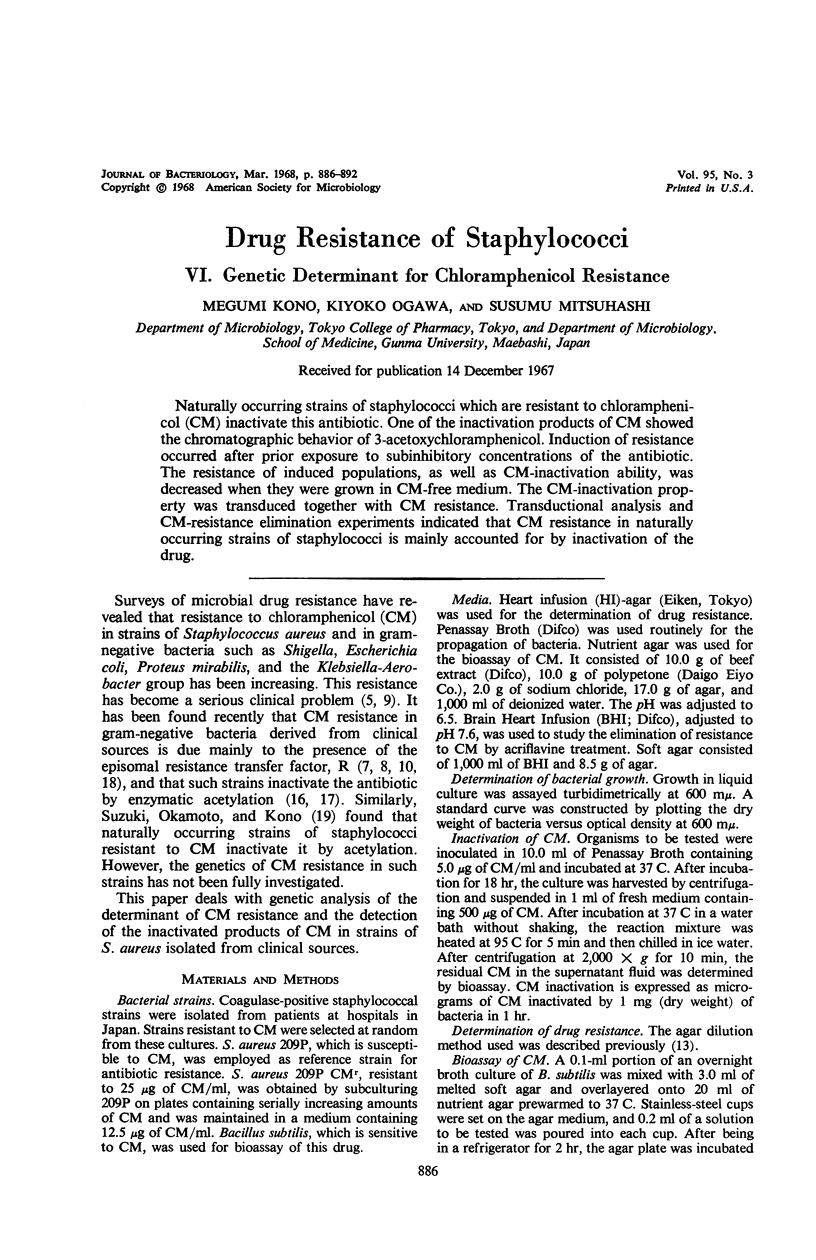
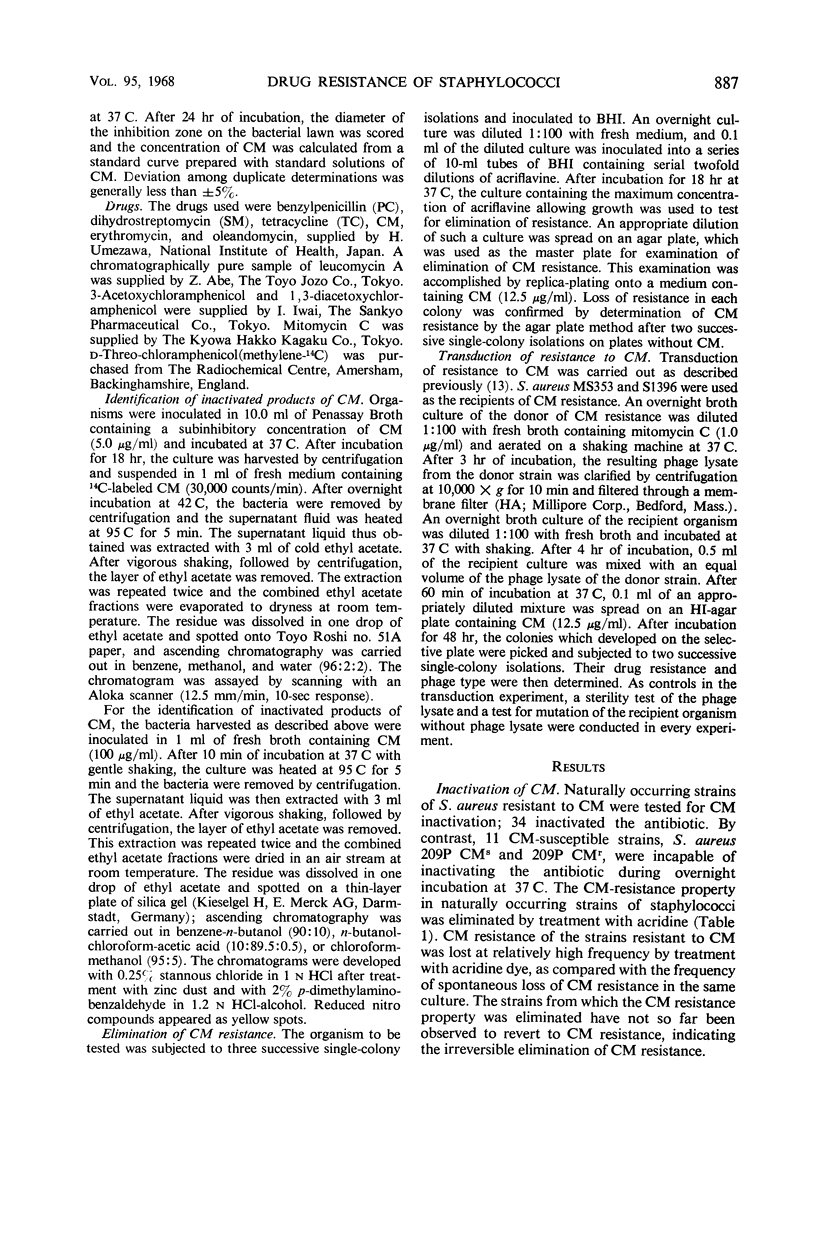

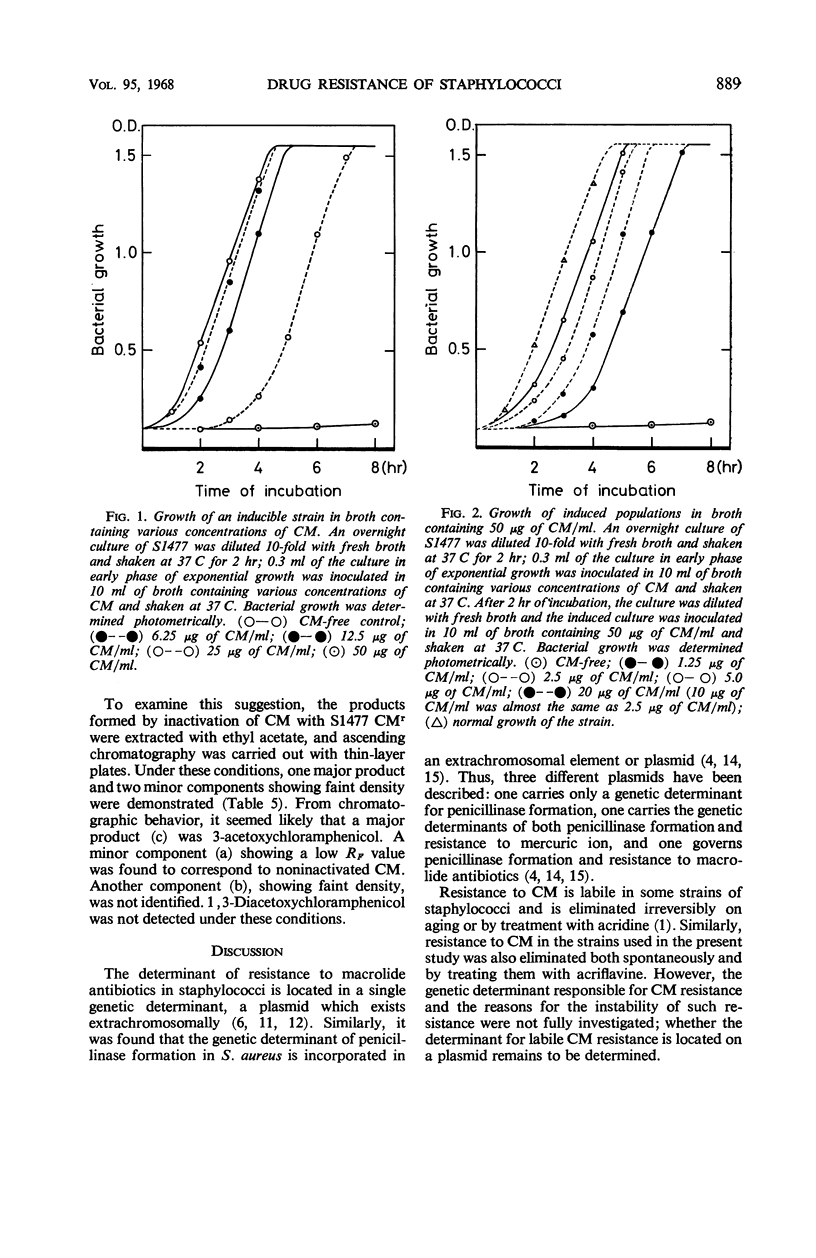
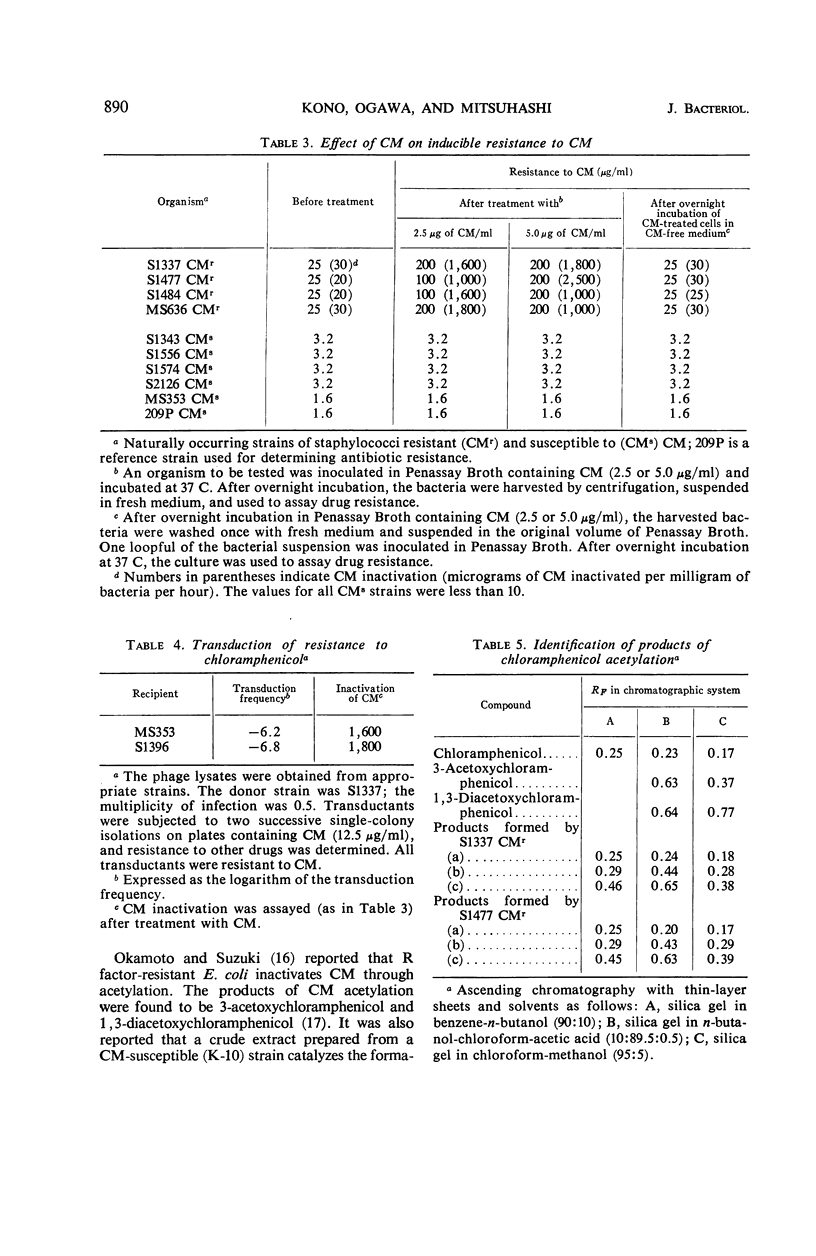
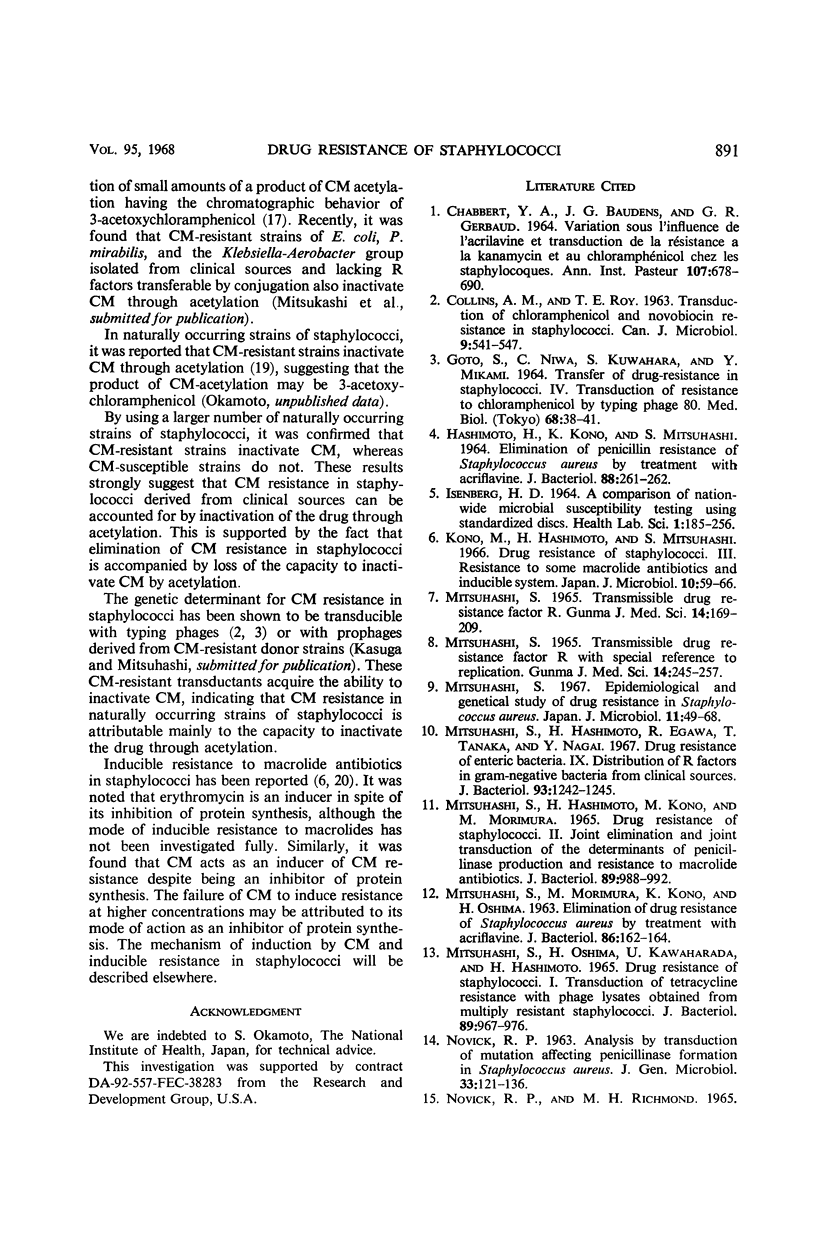
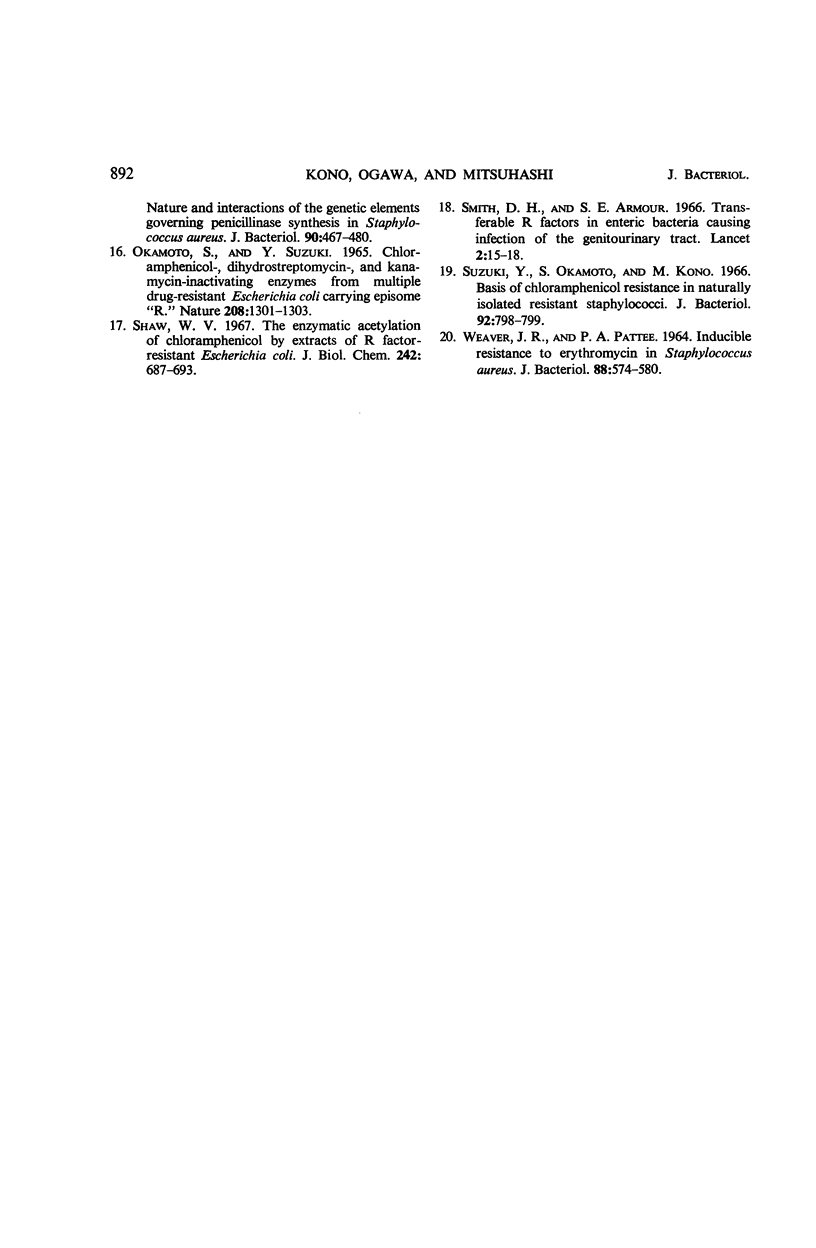
Selected References
These references are in PubMed. This may not be the complete list of references from this article.
- CHABBERT Y. A., BAUDENS J. G., GERBAUD G. R. VARIATIONS SOUS L'INFLUENCE DE L'ACRIFLAVINE ET TRANSDUCTION DE LA R'ESISTANCE A LA KANAMYCINE ET AU CHLORAMPH'ENICOL CHEZ LES STAPHYLOCOQUES. Ann Inst Pasteur (Paris) 1964 Nov;107:678–690. [PubMed] [Google Scholar]
- HASHIMOTO H., KONO K., MITSUHASHI S. ELIMINATION OF PENICILLIN RESISTANCE OF STAPHYLOCOCCUS AUREUS BY TREATMENT WITH ACRIFLAVINE. J Bacteriol. 1964 Jul;88:261–262. doi: 10.1128/jb.88.1.261-262.1964. [DOI] [PMC free article] [PubMed] [Google Scholar]
- Kono M., Hashimoto H., Mitsuhashi S. Drug resistance to staphylococci. 3. Resistance to some macrolide antibiotics and inducible system. Jpn J Microbiol. 1966 Apr;10(1):59–66. [PubMed] [Google Scholar]
- MITSUHASHI S., HASHIMOTO H., KONO M., MORIMURA M. DRUG RESISTANCE OF STAPHYLOCOCCI. II. JOINT ELIMINATION AND JOINT TRANSDUCTION OF THE DETERMINANTS OF PENICILLINASE PRODUCTION AND RESISTANCE TO MACROLIDE ANTIBIOTICS. J Bacteriol. 1965 Apr;89:988–992. doi: 10.1128/jb.89.4.988-992.1965. [DOI] [PMC free article] [PubMed] [Google Scholar]
- MITSUHASHI S., MORIMURA M., KONO K., OSHIMA H. ELIMINATION OF DRUG RESISTANCE OF STAPHYLOCOCCUS AUREUS BY TREATMENT WITH ACRIFLAVINE. J Bacteriol. 1963 Jul;86:162–164. doi: 10.1128/jb.86.1.162-164.1963. [DOI] [PMC free article] [PubMed] [Google Scholar]
- MITSUHASHI S., OSHIMA H., KAWAHARADA U., HASHIMOTO H. DRUG RESISTANCE OF STAPHYLOCOCCI. I. TRANSDUCTION OF TETRACYCLINE RESISTANCE WITH PHAGE LYSATES OBTAINED FROM MULTIPLY RESISTANT STAPHYLOCOCCI. J Bacteriol. 1965 Apr;89:967–976. doi: 10.1128/jb.89.4.967-976.1965. [DOI] [PMC free article] [PubMed] [Google Scholar]
- Mitsuhashi S. Epidemiological and genetical study of drug resistance in Staphylococcus aureus. Jpn J Microbiol. 1967 Mar;11(1):49–68. doi: 10.1111/j.1348-0421.1967.tb00320.x. [DOI] [PubMed] [Google Scholar]
- Mitsuhashi S., Hashimoto H., Egawa R., Tanaka T., Nagai Y. Drug resistance of enteric bacteria. IX. Distribution of R factors in gram-negative bacteria from clinical sources. J Bacteriol. 1967 Apr;93(4):1242–1245. doi: 10.1128/jb.93.4.1242-1245.1967. [DOI] [PMC free article] [PubMed] [Google Scholar]
- Mitsuhashi S. Transmissible drug-ressistance factor R with special reference to replication. Gunma J Med Sci. 1965 Dec;14(4):245–257. [PubMed] [Google Scholar]
- NOVICK R. P. ANALYSIS BY TRANSDUCTION OF MUTATIONS AFFECTING PENICILLINASE FORMATION IN STAPHYLOCOCCUS AUREUS. J Gen Microbiol. 1963 Oct;33:121–136. doi: 10.1099/00221287-33-1-121. [DOI] [PubMed] [Google Scholar]
- Okamoto S., Suzuki Y. Chloramphenicol-, dihydrostreptomycin-, and kanamycin-inactivating enzymes from multiple drug-resistant Escherichia coli carrying episome 'R'. Nature. 1965 Dec 25;208(5017):1301–1303. doi: 10.1038/2081301a0. [DOI] [PubMed] [Google Scholar]
- Shaw W. V. The enzymatic acetylation of chloramphenicol by extracts of R factor-resistant Escherichia coli. J Biol Chem. 1967 Feb 25;242(4):687–693. [PubMed] [Google Scholar]
- Smith D. H., Armour S. E. Transferable R factors in enteric bacteria causing infection of the genitourinary tract. Lancet. 1966 Jul 2;2(7453):15–18. doi: 10.1016/s0140-6736(66)91745-4. [DOI] [PubMed] [Google Scholar]
- Suzuki Y., Okamoto S., Kono M. Basis of chloramphenicol resistance in naturally isolated resistant staphylococci. J Bacteriol. 1966 Sep;92(3):798–799. doi: 10.1128/jb.92.3.798-799.1966. [DOI] [PMC free article] [PubMed] [Google Scholar]
- WEAVER J. R., PATTEE P. A. INDUCIBLE RESISTANCE TO ERYTHROMYCIN IN STAPHYLOCOCCUS AUREUS. J Bacteriol. 1964 Sep;88:574–580. doi: 10.1128/jb.88.3.574-580.1964. [DOI] [PMC free article] [PubMed] [Google Scholar]


